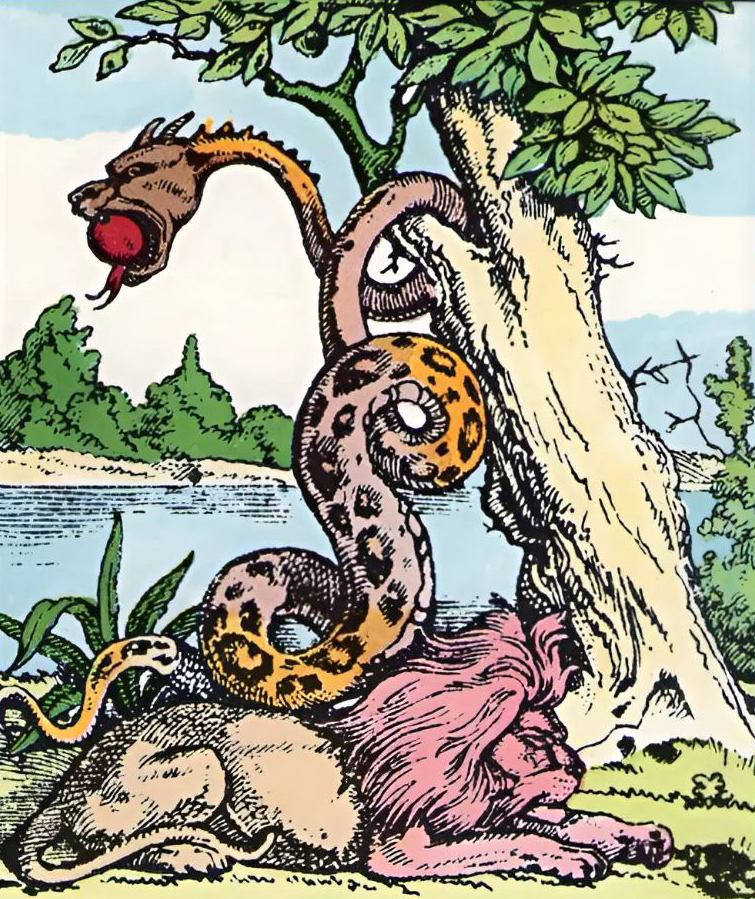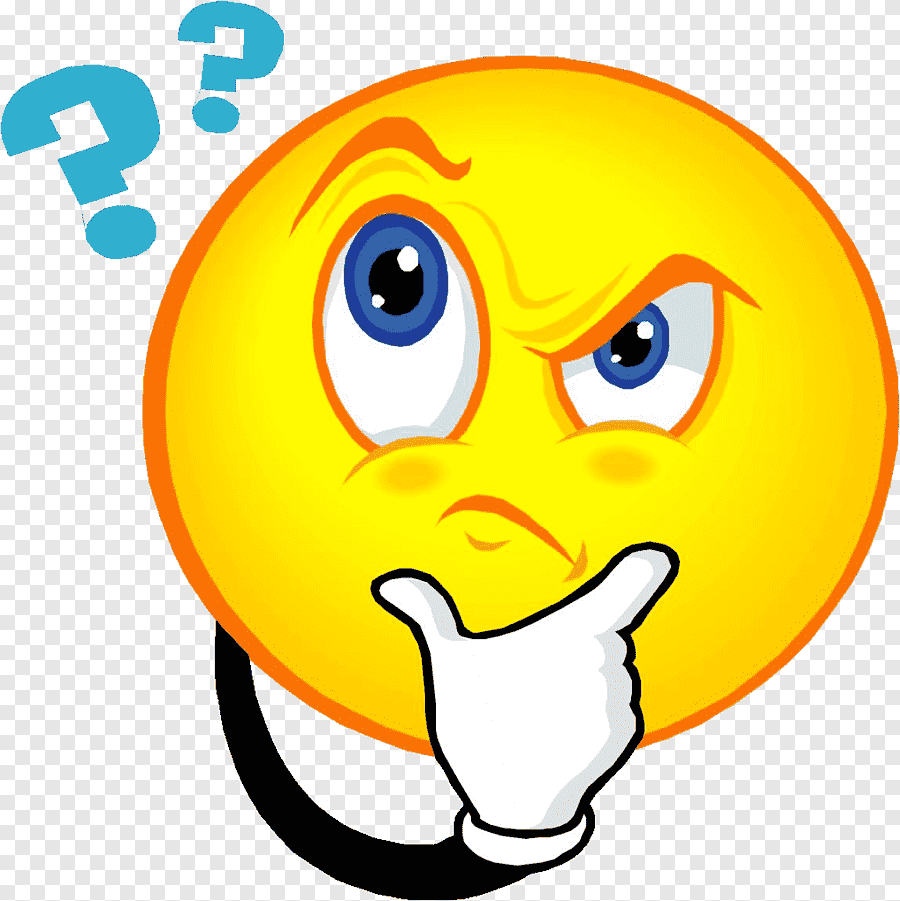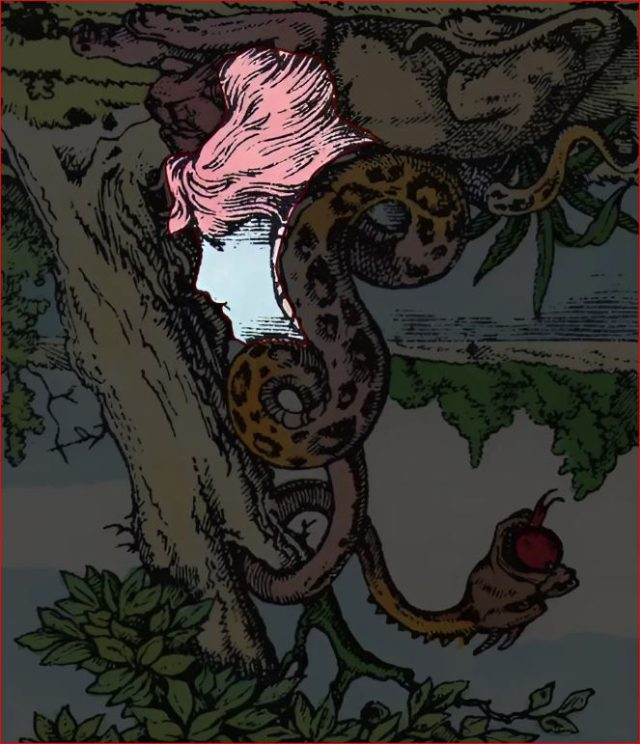Take a breath, look closely, and trust your eyes—then doubt them. In the puzzle above, a tangle of branches, a coiled snake, and a tempting apple compete for attention. Somewhere inside that scene, a girl is hiding in plain sight. Can you find her before the answer reveals itself? How fast can you spot her profile? And if you do see her, what detail gave her away first—hair, lips, or the curve of a cheek?
This isn’t just another “find the object” game. It’s a tiny masterclass in how your brain prioritizes information, how it fills in gaps, and how orientation quietly hijacks perception. Ready to put your eye skills to the test?

Why this puzzle tricks so many people
1) Orientation bias.
We’re conditioned to assume images are “right side up.” When the scene looks like a normal woodland tableau—tree, snake, apple—your brain locks into that interpretation. Anything that doesn’t fit gets discarded. In other words, you’re not seeing what’s there; you’re seeing what you expect.
2) Anchoring to the most dramatic object.
The snake dominates the composition, so most people search around it for clues. That anchor makes you miss the fact that the snake’s curves also outline something else entirely.
3) Color misdirection.
The warm pink highlight near the trunk reads like a patch of bark or a stray flower petal. Only later do you realize it doubles as flowing hair when the scene is viewed another way.
4) Negative-space camouflage.
Our brains are brilliant at recognizing faces—except when the face is carved out of the absence of detail. The girl’s features are not painted on top; they’re shaped by the edges of other objects. That hollow, pale area you’re ignoring? It’s a cheek, a chin, a nose.
Video : Hidden Object Game – OPTICAL ILLUSION PUZZLE | Emoji Quiz 🔎
5) Narrative expectation.
A serpent, a tree, an apple—your mind leaps to a familiar story and starts hunting for characters that match it. That story frame becomes a trap, nudging you away from the unexpected answer.
Before you start: three quick viewing tips
- Zoom out, then in. Faces often pop when you shrink the image or step back from your screen.
- Squint. Reducing detail helps you notice dominant contours—the silhouette of a profile may leap forward.
- Rotate your device or your head. If a composition feels stubborn, change the orientation. Your perception will reset in an instant.
Step-by-step guide to solve the puzzle
Step 1: Scan for clean contours.
Ignore the details for a moment. Instead of “tree” and “snake,” look for uninterrupted curves and straight edges. Notice the smooth light area hugged by darker outlines near the trunk—that’s not random glow; it’s a potential silhouette.

Step 2: Identify hairlike texture.
Focus on the pink, wavy area close to the tree. The strokes there don’t behave like bark or leaves—they ripple like strands. Mentally label it “possible hair.”
Step 3: Trace a face from forehead to chin.
Where light meets dark, follow the edge: a gentle slope (forehead), a small notch (nose), a soft angle (lips), and a rounded end (chin). Once you see those four landmarks, the brain starts auto-completing a face.
Step 4: Watch the snake’s curve become a shoulder line.
The coil that seems purely reptilian doubles as the outline of a neck and shoulder when viewed differently. Let that dual role sink in—this is the puzzle’s main trick.
Step 5: Re-check the background “void.”
That pale patch you dismissed becomes a cheek when your mind lets go of the original scene. The contrast between the light inner shape and the darker outlines is a classic face-in-negative-space illusion.
Step 6: Change your perspective—literally.
Here’s the decisive move: rotate the picture 180 degrees (turn it upside down). The moment you flip it, the pink area resolves into flowing hair, the pale space locks into a perfect profile, and the snake’s curves transform into the girl’s elegant posture. The hidden portrait clicks into place in one aha! second.

The reveal: where the girl is hiding
If you’ve rotated the image, you already see it: the girl is concealed as a right-facing portrait that becomes unmistakable when the picture is upside down.
- The pink section turns into her hair, cascading along the side of her head.
- The pale, smooth interior becomes her face, with a clear forehead, nose, lips, and chin.
- Parts of the snake’s body double as her neckline and shoulder line, elegantly framing the portrait.
- Elements that looked like foliage and bark act as shadowed background, helping the face pop.
This is a textbook example of how artists hide portraits inside landscapes by leveraging orientation, negative space, and shared contours. Upright, your brain says “snake and tree.” Upside down, it surrenders: “Of course—there’s the girl.”
Why tiny details derail solvers
Edge discipline. We tend to read textures (scales, bark, leaves) and forget that the boundary between textures carries the real information. Faces live in edges. Miss the boundary, miss the face.
Color expectations. We expect hair to be brown/blonde/black, not bright pink. That mismatch slows recognition—until orientation fixes it and the brain relaxes its rules.
Video : Hidden Pictures Puzzle #7 | 2020 | Can You Find All The Objects? | Highlights Kids
Story over shape. The serpent-and-apple motif whispers a famous tale, so we hunt for that story’s characters. The trick works because the girl’s portrait isn’t part of that narrative—she’s encoded in shape, not story.
First-glance commitment. Once your mind commits to one reading, it resists alternatives. The cure is mechanical: rotate, squint, shrink, or step away. Changing inputs forces a new interpretation.
Pro techniques to boost your puzzle-solving skills
- Use a “contour pass.” Trace long edges with your eyes only—don’t name objects. If an edge forms a clean S-curve, ask: could that be hair, jawline, or shoulder?
- Flip early, flip often. For any image that feels stubborn, rotate it 90° or 180°. Orientation is the cheapest superpower you’ve got.
- Search for symmetry—and its absence. Faces often pack symmetrical hints (balanced forehead/cheek arcs), even when embedded in chaotic scenes.
- Practice negative-space reading. Look at the gaps between objects. Designers and illustrators hide portraits there because most viewers ignore them.
- Set a timer. Give yourself 30–60 seconds before you allow a rotation. The time limit heightens focus and makes the “flip” payoff more dramatic.

Join the fun: share your moment of discovery
Now it’s your turn to keep the challenge alive:
- Comment: How long did it take you to spot the girl’s profile? Which clue tipped you off—hair, chin, or the overall silhouette after you flipped it?
- Share: Send this puzzle to a friend who loves visual riddles. Time them, and see who cracks it faster.
- Compare strategies: Did you rotate immediately or only after scanning every leaf and scale? Did squinting help?
And if you enjoyed this optical ride, don’t stop here. Train your eyes and brain with more puzzles that play with negative space, impossible perspectives, and hidden portraits. Each riddle sharpens pattern recognition, strengthens logical reasoning, and teaches you to question first impressions—a skill that’s useful far beyond brain teasers.